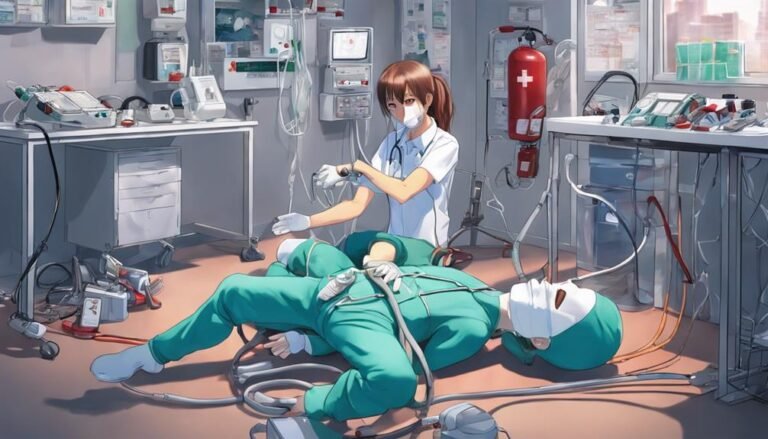How to Be More Innovative in Developing New Treatment Modalities
To innovate in developing new treatment modalities, remember that 'necessity is the mother of invention.' However, simply recognizing the need for innovation is not enough.
Have you ever wondered what it truly takes to push the boundaries of traditional healthcare practices and create groundbreaking treatments? By exploring unconventional approaches, fostering a spirit of collaboration, and embracing a forward-thinking mindset, you can pave the way for transformative advancements in the field.
Key Takeaways
- Foster a culture of experimentation and risk-taking for generating novel treatment ideas.
- Embrace cross-disciplinary collaboration to drive innovative problem-solving approaches.
- Develop personalized therapies with patient-centered design and technology integration.
- Break boundaries through interdisciplinary idea exchange, community involvement, and patient feedback.
Embracing a Creative Mindset
To foster innovation in developing new treatment modalities, embracing a mindset grounded in creativity is paramount. Creative brainstorming is essential in generating novel ideas for treatments. By engaging in inspirational ideation sessions, you can stimulate out-of-the-box thinking and challenge conventional approaches. Unleashing imagination allows for exploring unconventional solutions that may lead to groundbreaking advancements in healthcare.
Artistic experimentation plays an important role in testing innovative treatment modalities. Through trial and error, you can refine new ideas and transform them into tangible solutions. By approaching the development of treatments with a creative lens, you open up possibilities for unconventional yet effective interventions. Embracing a creative mindset not only encourages thinking beyond traditional boundaries but also fosters a culture of innovation within healthcare settings.
Cultivating a Culture of Experimentation
Cultivating a culture of experimentation involves actively encouraging and supporting the exploration of innovative ideas and methods within the domain of developing new treatment modalities. To foster an experimentation mindset, it is essential to create an environment where creative exploration is not only accepted but also celebrated. This can be achieved through various strategies, such as providing dedicated time for experimentation, offering resources for research and development, and recognizing and rewarding innovative thinking.
| Benefits of Cultivating a Culture of Experimentation |
|---|
| 1. Encourages risk-taking |
| 2. Fosters creativity and innovation |
| 3. Drives continuous improvement |
| 4. Enhances problem-solving skills |
| 5. Increases adaptability and resilience |
Fostering Cross-Disciplinary Collaboration
Encouraging team diversity not only brings a variety of perspectives but also enhances creativity in problem-solving.
When different disciplines come together, the exchange of ideas sparks innovation and can lead to groundbreaking solutions.
Collaborative approaches to addressing challenges across fields can result in more detailed and effective treatment modalities.
Team Diversity Benefits
Diverse teams in the domain of developing new treatment modalities not only enhance creativity but also promote innovative problem-solving through cross-disciplinary collaboration. Diversity inclusion fosters a rich tapestry of perspectives, leading to more exhaustive solutions. Team dynamics benefit from varied backgrounds, enhancing communication and decision-making processes. Different expertise contributes to well-rounded strategies, ensuring all aspects are considered. Varied viewpoints challenge assumptions and drive thinking outside the box. Collaboration across disciplines sparks creativity and opens doors to unconventional approaches.
- Perspectives: Various viewpoints lead to exhaustive solutions.
- Communication: Diverse teams enhance communication within the group.
- Expertise: Different backgrounds contribute to well-rounded strategies.
- Challenging Assumptions: Varied viewpoints challenge conventional thinking.
- Creativity: Collaboration across disciplines sparks innovative ideas.
Interdisciplinary Idea Exchange
Interdisciplinary idea exchange fosters a dynamic environment where varying perspectives converge to drive innovative solutions in developing new treatment modalities. Through interdisciplinary brainstorming, creativity workshops, and knowledge sharing, experts from different fields come together to collaborate and generate novel ideas.
Brainstorming sessions allow for the free flow of thoughts, enabling participants to explore unconventional approaches and challenge traditional practices. This cross-disciplinary collaboration not only enhances creativity but also encourages thinking outside the box. By combining insights from diverse backgrounds, such as medicine, technology, and psychology, new perspectives emerge, leading to breakthroughs in treatment modalities.
Embracing interdisciplinary idea exchange creates a fertile ground for innovation and paves the way for transformative advancements in healthcare.
Collaborative Problem-Solving Approaches
In fostering cross-disciplinary collaboration for collaborative problem-solving approaches, the convergence of diverse perspectives enables the exploration of innovative solutions in developing new treatment modalities. When tackling complex challenges in healthcare, leveraging problem-solving strategies that encourage collaboration across different disciplines can lead to groundbreaking advancements.
Here are some key points to bear in mind:
- Enhanced Creativity: Combining insights from various fields sparks creativity and fosters out-of-the-box thinking.
- Increased Efficiency: Collaborative problem-solving approaches streamline processes and promote efficient resource utilization.
- Holistic Perspective: Integrating diverse viewpoints offers a holistic understanding of problems, leading to thorough solutions.
- Accelerated Innovation: Cross-disciplinary collaboration accelerates the innovation process by pooling together unique expertise.
- Improved Outcomes: Innovative solutions derived from collaborative problem-solving approaches often result in improved patient outcomes and enhanced healthcare delivery.
Leveraging Technology for Innovation
Leveraging technology in the development of new treatment modalities has become an essential aspect of innovation in the healthcare industry. Incorporating tech integration and creative solutions can lead to the emergence of disruptive ideas that enhance patient care and outcomes greatly. By harnessing innovation tools, healthcare professionals can revolutionize the way treatments are conceptualized and delivered.
To illustrate the impact of leveraging technology, consider the following table showcasing examples of how different technologies can be utilized in the development of new treatment modalities:
| Technology | Application | Benefits |
|---|---|---|
| Artificial Intelligence | Diagnostics and Predictions | Faster, more accurate assessments |
| Virtual Reality | Pain Management | Non-pharmacological treatment options |
| Wearable Devices | Patient Monitoring | Continuous real-time health tracking |
Through the strategic integration of these technologies, healthcare providers can create innovative treatment modalities that are more effective, personalized, and efficient. This tech-driven approach opens up new avenues for improving patient care and driving advancements in the medical field.
Thinking Beyond Traditional Methods
When considering new treatment modalities, it's important to embrace unconventional approaches to reap the benefits they may offer. Innovation thrives when you step outside the confines of traditional methods, sparking creativity and pushing boundaries in the field.
Unconventional Approach Benefits
Utilizing innovative strategies beyond conventional methods can yield significant benefits in the development of new treatment modalities. When exploring unconventional techniques and creative solutions, you open doors to unique possibilities that traditional approaches may overlook. Thinking outside the box and embracing innovative ideas can lead to groundbreaking advancements in the medical field.
Here are some key benefits of adopting unconventional approaches:
- Enhanced Efficacy: Unconventional methods may offer improved effectiveness in treating complex conditions.
- Novel Therapies: Thinking innovatively can lead to the development of entirely new treatment modalities.
- Personalized Care: Unconventional approaches allow for tailored treatments that better suit individual patient needs.
- Cost Efficiency: Innovative ideas can result in cost-effective solutions for developing new treatments.
- Competitive Edge: Embracing unconventional techniques can give you a competitive advantage in the healthcare industry.
Innovation Sparks Creativity
To foster creativity and drive innovation in developing new treatment modalities, exploring unconventional pathways can release untapped potential and inspire novel solutions in the medical field. Creativity sparks innovation by challenging traditional norms and thinking patterns. When healthcare professionals step outside their comfort zones, they open doors to new possibilities and breakthroughs. Innovation ignites progress by pushing boundaries and seeking alternative approaches. By embracing creativity and thinking beyond traditional methods, researchers can uncover innovative treatment modalities that have the potential to revolutionize patient care.
| Unconventional Pathways | Untapped Potential | Novel Solutions |
|---|---|---|
| Challenging traditional norms | Exploring new technologies | Implementing creative strategies |
| Collaborating across disciplines | Thinking outside the box | Adapting existing methods |
Through these unconventional approaches, the seeds of innovation are planted, ready to blossom into groundbreaking advancements in medical treatment.
Breaking Old Boundaries
Breaking old boundaries requires a willingness to challenge conventional practices and explore innovative approaches in the development of new treatment modalities. To truly think differently and challenge norms within this setting, consider the following:
- Interdisciplinary Collaboration: Engage experts from diverse fields to bring fresh perspectives.
- Patient-Centered Design: Tailor treatments to individual needs and preferences.
- Utilize Technology: Incorporate cutting-edge tools for more effective interventions.
- Embrace Risk-Taking: Be open to experimentation and learn from failures.
- Community Involvement: Involve patients and caregivers in co-designing solutions for better outcomes.
Incorporating Patient-Centered Design
Innovating treatment modalities by incorporating patient-centered design principles has shown to enhance treatment outcomes and patient satisfaction greatly. By focusing on user experience and integrating research into the development process, healthcare providers can create more effective and personalized treatment modalities. Patient feedback plays a vital role in this process, guiding the incorporation strategy and ensuring that treatments align with patient needs and preferences.
| User Experience | Research Integration | Patient Feedback | Incorporation Strategy |
|---|---|---|---|
| Design treatments that prioritize patient comfort and convenience | Utilize latest research findings to inform treatment development | Actively seek and analyze patient opinions and experiences | Integrate patient feedback into treatment design and implementation |
Encouraging Risk-Taking and Adaptability
Encouraging healthcare providers to embrace risk-taking and adaptability in treatment development can lead to breakthrough innovations that address unmet patient needs and improve overall care outcomes. By encouraging boldness, healthcare professionals can push the boundaries of traditional treatment approaches and explore new possibilities for improved patient outcomes.
Promoting flexibility allows for quick adjustments to be made based on emerging data and patient responses, fostering a more responsive and patient-centered approach to care.
Here are key strategies to encourage risk-taking and adaptability in treatment development:
- Foster a Culture of Innovation: Create an environment where healthcare providers feel empowered to propose and test new ideas.
- Embrace Failure as a Learning Opportunity: Encourage healthcare professionals to view setbacks as valuable lessons that can inform future innovative endeavors.
- Provide Resources for Experimentation: Support initiatives that allow for experimentation and exploration of new treatment modalities.
- Encourage Collaboration: Promote interdisciplinary collaboration to bring diverse perspectives and expertise to the development process.
- Celebrate Successes and Learn from Failures: Acknowledge and learn from both successful innovations and unsuccessful attempts to drive continuous improvement in treatment development.
Measuring and Iterating for Success
To optimize the development of new treatment modalities, it's imperative to establish robust mechanisms for measuring outcomes and iterating based on gathered data. Data-driven analysis plays a vital role in evaluating the effectiveness and efficiency of new treatment modalities. By collecting and analyzing data on patient outcomes, side effects, and adherence rates, you can gain valuable insights into what works and what needs improvement. Continuous improvement is key to refining and enhancing treatment modalities over time.
Measuring outcomes allows you to objectively evaluate the impact of new modalities on patient health and quality of life. Through data analysis, you can identify patterns, trends, and areas for optimization. By iterating based on this data, you can make informed decisions that drive innovation and progress in treatment development.
Conclusion
As you initiate on the journey of developing new treatment modalities, remember that innovation isn't a destination, but a continuous process of exploration and discovery.
By embracing creativity, fostering collaboration, and leveraging technology, you can break free from the confines of traditional methods and truly make a difference in patient care.
So, dare to step outside the box, take risks, and adapt to challenges along the way. Remember, the sky's the limit in the world of healthcare innovation.







